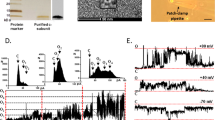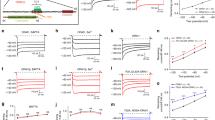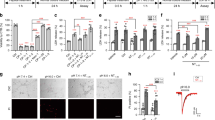Abstract
Hyperactivation of the Caenorhabditis elegans MEC-4 Na+ channel of the DEG/ENaC superfamily (MEC-4(d)) induces neuronal necrosis through an increase in intracellular Ca2+ and calpain activation. How exacerbated Na+ channel activity elicits a toxic rise in cytoplasmic Ca2+, however, has remained unclear. We tested the hypothesis that MEC-4(d)-induced membrane depolarization activates voltage-gated Ca2+ channels (VGCCs) to initiate a toxic Ca2+ influx, and ruled out a critical requirement for VGCCs. Instead, we found that MEC-4(d) itself conducts Ca2+ both when heterologously expressed in Xenopus oocytes and in vivo in C. elegans touch neurons. Data generated using the Ca2+ sensor cameleon suggest that an induced release of endoplasmic reticulum (ER) Ca2+ is crucial for progression through necrosis. We propose a refined molecular model of necrosis initiation in which Ca2+ influx through the MEC-4(d) channel activates Ca2+-induced Ca2+ release from the ER to promote neuronal death, a mechanism that may apply to neurotoxicity associated with activation of the ASIC1a channel in mammalian ischemia.
This is a preview of subscription content, access via your institution
Access options
Subscribe to this journal
Receive 12 print issues and online access
$209.00 per year
only $17.42 per issue
Buy this article
- Purchase on Springer Link
- Instant access to full article PDF
Prices may be subject to local taxes which are calculated during checkout






Similar content being viewed by others


Change history
14 November 2004
added note to xml, appended aop pdf with web amendment, corrected online details will be added to issue pdf.
References
Demaurex, N. & Distelhorst, C. Apoptosis—the calcium connection. Science 300, 65–67 (2003).
Leist, M. & Nicotera, P. Apoptosis, excitotoxicity, and neuropathology. Exp. Cell Res. 239, 183–201 (1998).
Verkhratsky, A. & Toescu, E.C. Endoplasmic reticulum Ca2+ homeostasis and neuronal death. J. Cell. Mol. Med. 7, 351–361 (2003).
Mattson, M.P. et al. Calcium signaling in the ER: its role in neuronal plasticity and neurodegenerative disorders. Trends Neurosci. 23, 222–229 (2000).
Xu, K., Tavernarakis, N. & Driscoll, M. Necrotic cell death in C. elegans requires the function of calreticulin and regulators of Ca2+ release from the endoplasmic reticulum. Neuron 31, 957–971 (2001).
Driscoll, M. & Chalfie, M. The mec-4 gene is a member of a family of Caenorhabditis elegans genes that can mutate to induce neuronal degeneration. Nature 349, 588–593 (1991).
Heintz, N. & Zoghbi, H.Y. Insights from mouse models into the molecular basis of neurodegeneration. Annu. Rev. Physiol. 62, 779–802 (2000).
Driscoll, M. & Gerstbrein, B. Dying for a cause: invertebrate genetics takes on human neurodegeneration. Nat. Rev. Gen. 4, 181–194 (2003).
Lai, C.C., Hong, K., Kinnell, M., Chalfie, M. & Driscoll, M. Sequence and transmembrane topology of MEC-4, an ion channel subunit required for mechanotransduction in Caenorhabditis elegans. J. Cell Biol. 133, 1071–1081 (1996).
Goodman, M.B. et al. MEC-2 regulates C. elegans DEG/ENaC channels needed for mechanosensation. Nature 415, 1039–1042 (2002).
Chelur, D.S. et al. The mechanosensory protein MEC-6 is a subunit of the C. elegans touch-cell degenerin channel. Nature 420, 669–673 (2002).
Bianchi, L. & Driscoll, M. The molecular basis of touch sensation as modeled in Caenorhabditis elegans. in Transduction Channels in Sensory Cells (eds Frings, S. & Bradely, J.) 1–29 (Wiley-VCH, Weinheim, Germany, 2004).
Suzuki, H. et al. In vivo imaging of C. elegans mechanosensory neurons demonstrates a specific role for the MEC-4 channel in the process of gentle touch sensation. Neuron 39, 1005–1017 (2003).
Waldmann, R., Champigny, G., Voilley, N., Lauritzen, I. & Lazdunski, M. The mammalian degenerin MDEG, an amiloride-sensitive cation channel activated by mutations causing neurodegeneration in Caenorhabditis elegans. J. Biol. Chem. 271, 10433–10436 (1996).
Adams, C.M., Snyder, P.M., Price, M.P. & Welsh, M.J. Protons activate brain Na+ channel 1 by inducing a conformational change that exposes a residue associated with neurodegeneration. J. Biol. Chem. 273, 30204–30207 (1998).
Chalfie, M. & Wolinsky, E. The identification and suppression of inherited neurodegeneration in Caenorhabditis elegans. Nature 345, 410–416 (1990).
Hong, K. & Driscoll, M. A transmembrane domain of the putative channel subunit MEC-4 influences mechanotransduction and neurodegeneration in C. elegans. Nature 367, 470–473 (1994).
Price, M.P. et al. The mammalian sodium channel BNC1 is required for normal touch sensation. Nature 407, 1007–1011 (2000).
Wemmie, J.A. et al. The acid-activated ion channel ASIC contributes to synaptic plasticity, learning and memory. Neuron 34, 463–477 (2002).
Wemmie, J.A. et al. Acid-sensing ion channel 1 is localized in brain regions with high synaptic density and contributes to fear conditioning. J. Neurosci. 23, 5496–5502 (2003).
Yermolaieva, O., Leonard, A.S., Schnizler, M.K., Abboud, F.M. & Welsh, M.J. Extracellular acidosis increases neuronal cell calcium by activating acid-sensing ion channel 1a. Proc. Natl. Acad. Sci. USA 101, 6752–6757 (2004).
Xiong, Z.G. et al. Neuroprotection in ischemia: blocking calcium-permeable acid-sensing ion channels. Cell 118, 687–698 (2004).
Syntichaki, P., Xu, K., Driscoll, M. & Tavernarakis, N. Specific aspartyl and calpain proteases are required for neurodegeneration in C. elegans. Nature 419, 939–944 (2002).
Metzstein, M.M., Stanfield, G.M. & Horvitz, H.R. Genetics of programmed cell death in C. elegans: past, present and future. Trends Genet. 14, 410–416 (1998).
Berridge, M.J. Inositol trisphosphate and calcium signalling. Nature 361, 315–325 (1993).
Verkhratsky, A. & Shmigol, A. Calcium-induced calcium release in neurones. Cell Calcium 19, 1–14 (1996).
Bargmann, C.I. Neurobiology of the Caenorhabditis elegans genome. Science 282, 2028–2033 (1998).
Jeziorski, M.C., Greenberg, R.M. & Anderson, P.A. The molecular biology of invertebrate voltage-gated Ca2+ channels. J. Exp. Biol. 203, 841–856 (2000).
Kuruma, A. & Hartzell, H.C. Dynamics of calcium regulation of chloride currents in Xenopus oocytes. Am. J. Physiol. 276, C161–C175 (1999).
Amasheh, S. & Weber, W. Further characteristics of the Ca2+-inactivated Cl− channel in Xenopus laevis oocytes. J. Membr. Biol. 172, 169–179 (1999).
Weber, W. Ion currents of Xenopus laevis oocytes: state of the art. Biochim. Biophys. Acta 1421, 213–233 (1999).
Woodhull, A.M. Ionic blockage of sodium channels in nerve. J. Gen. Physiol. 61, 687–708 (1973).
Sheng, S., Li, J., McNulty, K.A., Avery, D. & Kleyman, T.R. Characterization of the selectivity filter of the epithelial sodium channel. J. Biol. Chem. 275, 8572–8581 (2000).
Sheng, S., McNulty, K.A., Harvey, J.M. & Kleyman, T.R. Second transmembrane domains of ENaC subunits contribute to ion permeation and selectivity. J. Biol. Chem. 276, 44091–44098 (2001).
Kellenberger, S., Hoffmann-Pochon, N., Gautschi, I., Schneeberger, E. & Schild, L. On the molecular basis of ion permeation in the epithelial Na+ channel. J. Gen. Physiol. 114, 13–30 (1999).
Hong, K., Mano, I. & Driscoll, M. In vivo structure–function analyses of Caenorhabditis elegans MEC-4, a candidate mechanosensory ion channel subunit. J. Neurosci. 20, 2575–2588 (2000).
Lee, R.Y., Lobel, L., Hengartner, M., Horvitz, H.R. & Avery, L. Mutations in the α1 subunit of an L-type voltage-activated Ca2+ channel cause myotonia in Caenorhabditis elegans. EMBO J. 16, 6066–6076 (1997).
Garcia-Anoveros, J., Garcia, J.A., Liu, J.D. & Corey, D.P. The nematode degenerin UNC-105 forms ion channels that are activated by degeneration- or hypercontraction-causing mutations. Neuron 20, 1231–1241 (1998).
Waldmann, R., Champigny, G., Bassilana, F., Heurteaux, C. & Lazdunski, M. A proton-gated cation channel involved in acid-sensing. Nature 386, 173–177 (1997).
Chu, X.P. et al. Proton-gated channels in PC12 cells. J. Neurophysiol. 87, 2555–2561 (2002).
Gunthorpe, M.J., Smith, G.D., Davis, J.B. & Randall, A.D. Characterisation of a human acid-sensing ion channel (hASIC1a) endogenously expressed in HEK293 cells. Pflugers Arch. 442, 668–674 (2001).
Sutherland, S.P., Benson, C.J., Adelman, J.P. & McCleskey, E.W. Acid-sensing ion channel 3 matches the acid-gated current in cardiac ischemia-sensing neurons. Proc. Natl. Acad. Sci. USA 98, 711–716 (2001).
Zhang, P. & Canessa, C.M. Single channel properties of rat acid-sensitive ion channel-1α, -2a, and -3 expressed in Xenopus oocytes. J. Gen. Physiol. 120, 553–566 (2002).
Bassler, E.L., Ngo-Anh, T.J., Geisler, H.S., Ruppersberg, J.P. & Grunder, S. Molecular and functional characterization of acid-sensing ion channel (ASIC) 1b. J. Biol. Chem. 276, 33782–33787 (2001).
Mesaeli, N. et al. Calreticulin is essential for cardiac development. J. Cell Biol. 144, 857–868 (1999).
Brenner, S. The genetics of Caenorhabditis elegans. Genetics 77, 71–94 (1974).
Bianchi, L. et al. Mechanisms of IKs suppression in LQT1 mutants. Am. J. Physiol. 279, H3003–H3011 (2000).
Christensen, M. et al. A primary culture system for functional analysis of C. elegans neurons and muscle cells. Neuron 33, 503–514 (2002).
Thomas, D. et al. A comparison of fluorescent Ca2+ indicator properties and their use in measuring elementary and global Ca2+ signals. Cell Calcium 28, 213–223 (2000).
Kerr, R. et al. Optical imaging of calcium transients in neurons and pharyngeal muscle of C. elegans. Neuron 26, 583–594 (2000).
Acknowledgements
We thank W.-H. Lee and M. Lizzio for help with molecular biology; J. Pintar and M.-S. Hsu for the use of the vibrotome for cutting oocyte sections; M. Chalfie for the mec clones; and A. Galli, I. Mano and G. Patterson for critically reading the manuscript. This work was supported by grants from the National Institutes of Health (NS034435 and NS37955 to M.D., NS049511 to L.B., NSF00139 Minority Postdoctoral Fellowship to D.C.R.), from the New Jersey Commission on Spinal Cord Research, and from Psykiatrisk Forskningsfond and Novo Nordisk (to C.F.-J.) and from Fulbright and Louis Bevier Fellowships (to B.G.).
*Note: The version of this article that was published online on November 7, 2004 omitted one of the supporting National Institutes of Health grant numbers in the Acknowledgments. W.R.S. was supported by NIH grant number DA016445. The online version was corrected on 14 November 2004, and the printed version of the article is correct. This change affects the HTML and PDF versions of the article; print will be corrected before publication.
Author information
Authors and Affiliations
Corresponding author
Ethics declarations
Competing interests
The authors declare no competing financial interests.
Supplementary information
Supplementary Fig. 1
Properties of cultured C. elegans touch neurons. (a) Primary culture of strain bzIs18 which expresses yellow cameleon 2.12 (yc2.12) in the mechanosensory neurons. All neurons expressing cameleon show neuronal morphology. Scale bar 10 micron. (b) Example of cultured touch neuron expressing GFP under the mechanosensory neuron specific promoter pmec-4. On the bottom, the same neuron was stained with an antibody raised against acetylated α-tubulin (Sigma); a unique modification to touch neurons in vivo3. (c) C. elegans embryonic cells were cultured from pmec-4::gfp and mec-4(d);pmec-4::gfp nematodes. Cells were plated at the same density (~200,000 cells/cm2) in individual wells and the number of touch neurons/40x field (identified as expressing GFP) were counted 24 hours and 4 days after plating. Ten fields per sample were counted. (d) Experiment conducted similarly to panel c for WT and mec-4(d) touch neurons plus and minus genetic modification (calreticulin null mutant bz29) and pharmacological treatments (10 µM dantrolene or 10 µM amiloride). The number of touch neurons/40x field was determined 24 hours after plating. Ten fields per sample were counted. (JPG 25 kb)
Supplementary Fig. 2
Calibration of yellow cameleon 2.12 in cultured neurons. (a) Pseudocolor image of cultured mechanosensory neurons in low calcium (0 mM Ca2+, 5 mM EGTA) left and high calcium (10 mM Ca2+) right. Pseudocolor scale bar indicates the yellow fluorescent protein/cyan fluorescent protein (YFP/CFP) emission ratio. (b) Representative trace from cameleon calibration in cultured neurons. Prior to recording, cultures were incubated 25-30 minutes in a solution with a defined concentration of free calcium in the presence of the calcium ionophore Br-A23187 (10 µM). The solution also contained Rotenone (10mM) and 2-deoxy-D-glucose (1.8mM) to block active pumps. (c) Yc2.12 calibration curve showing the aggregate results from 4-7 cells measured at each of 11 different free calcium solutions. Ratio is normalized to the maximal ratio change for the individual cell. A biphasic calcium dependence gave the best fit, with apparent EC50 values of 0.4 µM and 40 µM. The maximum/minimum ratio change was 81 ± 2 % (n = 12). (d) Estimate of the intracellular calcium concentration in cultured neurons. Cultured neurons were imaged 3 minutes in a standard extracellular saline solution. Five mM EGTA, ionophore, Rotenone and 2-deoxy-D-glucose were added to determine the minimum ratio and 10 mM CaCl2, ionophore and metabolic blockers added to determine the maximum ratio value. Resting ratio in cultured neurons was measured to 22 ±7 % (n = 2, 18 cells) of maximal ratio change corresponding to a calcium concentration of approx. 200 nM. (JPG 47 kb)
Supplementary Fig. 3
The MEC-4(A713T/G717E) mutant channel exhibits smaller Ca2+ influx, altered sensitivity to divalent cations and altered sensitivity to amiloride, suggesting a role for G717 in divalent cation interaction and amiloride binding. (a) Average current/voltage relationships of Na+ currents generated in oocytes expressing MEC-4(d) + MEC-10(d) + MEC-2 + MEC-6 (filled squares, n=8) and MEC-4(A713T/G717E) + MEC-10(d) + MEC-2 + MEC-6 (open squares, n=6). Data were obtained from the same batch of oocytes and injected with the same amount of RNA. (b) Ca2+-activated Cl- current amplitude at -160 mV from the same oocytes shown in panel a. Data are expressed as mean ± SE and ** indicates p⩽0.01 by t Test. The MEC-4(A713T/G717E) channel shows strong inward rectification not present in the MEC-4(A713T) channel. (c) Current-voltage relationships of currents recorded from oocytes injected with mec-4(A713T/G717E)+mec-10(d)+mec-2+mec-6. Oocytes were perfused with a physiological NaCl solution (MgCl2 2mM and CaCl2 1 mM, filled squares, n=7) and with a divalent free solution (filled triangles, n=7). (d) Same as in panel a for mec-4(A713T)+mec-10(d)+mec-2+mec-6 injected oocytes (n=5). (e) Amiloride sensitivity of MEC-4(A713T/G717E). Sensitivity to 10 µM amiloride was determined at -160 using the Ca2+-activated Cl- currents as read-out of Ca2+ permeation through MEC-4 channels. The value reported for MEC-4(A713T) is obtained from figure 3g, (n=5). * designates p⩽0.05 by t Test. (JPG 26 kb)
Supplementary Table 1
Results of manipulations designed to disrupt potential sources of plasma membrane Ca+ entry on mec-4(d)-induced necrosis. (PDF 120 kb)
Rights and permissions
About this article
Cite this article
Bianchi, L., Gerstbrein, B., Frøkjær-Jensen, C. et al. The neurotoxic MEC-4(d) DEG/ENaC sodium channel conducts calcium: implications for necrosis initiation. Nat Neurosci 7, 1337–1344 (2004). https://doi.org/10.1038/nn1347
Received:
Accepted:
Published:
Issue Date:
DOI: https://doi.org/10.1038/nn1347
This article is cited by
-
A guide to cell death pathways
Nature Reviews Molecular Cell Biology (2023)
-
Ion Channel Dysregulation Following Intracerebral Hemorrhage
Neuroscience Bulletin (2023)
-
Transcriptional control of non-apoptotic developmental cell death in C. elegans
Cell Death & Differentiation (2016)
-
Exposure of phosphatidylserine on the cell surface
Cell Death & Differentiation (2016)
-
Autophagy in the physiology and pathology of the central nervous system
Cell Death & Differentiation (2015)

